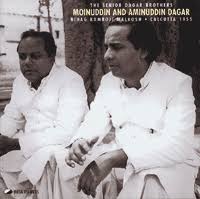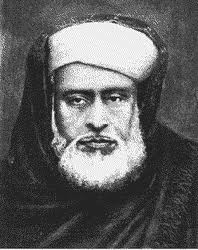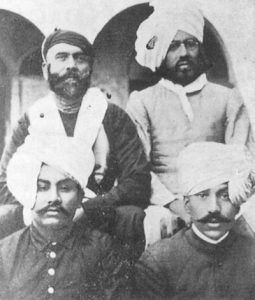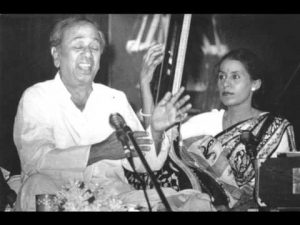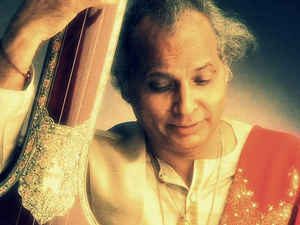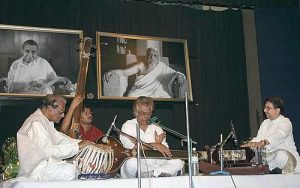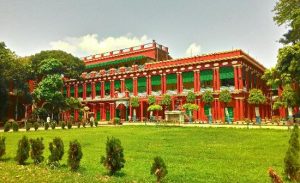| Told by | Vidushi Purnima Sen |
| Obtained by | Sukanya Sarkar |
| Date | 19th April 2015 |
| Place | 149/1C Rash Bihari Avenue. Kolkata -29 |
| About the speaker | Vidushi Purnima Sen is an exponent of Agra –Atruli gharana. She was the disciple of Vilayat Hussain Khan of Agra-Atrauli gharana. She has also learnt from Ata Hussain Khan and Sharafat Hussain Khan of the same gharana. She is considered as the heir of Agra-Atrauli gharana. |
| Tags | Baroda, Kolkata, New Theatre, Assistant Music Director, Kshirodbaron, Kheyal, Thumri, Ram Mohan Library, Sandhya Mukherjee, Jamini Ganguli, Girija Shankar Chakraborty, Malkaunsh, Bhupali, Taan, Vistaar, Tabla, Kirtana, Ratneshwar Mukherjee, Bhajan, Rabindra sangeet, Bhupen Hazarika, 1957, Delhi, Jawaharlal Nehru, Vilayat Hussain Khan, Sumati Mutatkar, Ram Marathe, Gajanan Rao Joshi, Raga, Bandish, Ata Hussain khan, Mahishadala Rajbari, Desi Todi, Complex Taan, Sharafat Hussain Khan, Yunush Khan, Gara-Kanada, Simple Taan, Malkaunsh, Iman, Behag, 1980, 1960-61, 1970, Latafat Hussain Khan, Khadim Hussain, 1985, Sujani Malhar, Sur Malhar, Haji Sujan Khan, Deepak Jyot Raga, Nouharbani, All India Radio, Agra Gharana |
| Language | Bengali |
Vidushi Purnima Sen speaks:
Metadata generated by Dr. Suranjita Paul
Text Version:
I: If you could begin with your experience as a child training under your guru.
P: When I was very young, I used to sing on my own. But after the Second World War, when we moved from Baroda to Kolkata, for the three to four years that we were here, I did have a teacher. I don’t remember his full name, we called him Khirod babu. He was my father’s friend. He worked as an assistant music director at New Theatre. He knew singing. He used to teach me. I was only around seven years old then. He taught me some songs. He taught me kheyal, thumri. And he used to ask me to go to competitions, and he even made me go, I forgot to say that. I even won first and second place in these competitions. I won medals also. That was that. After that we went…
P: Which year was this?
I: This was ’46-47.
I: This was at the Rammohan Library?
P: Yes. There used to be competitions at Rammohan Library. Either All Bengal or All India. I was very young then.
I: Nikhil Banerjee won some award there?
P: Sandhya di. Sandhya Mukherjee. She was the senior-most. She was Jamini babu’s student. She used to win first place in everything. She would win the first prize for every kind of song. I was very young. I won first place once, and the other time I was the runners-up. After that, there was a break. I went to America. When we used to come back from America for two months or six months…this was in the early 1950s…
I: Did you come and stay here for two months and six months?
P: Yes, Yes. We used to go back. My mother used to come because she had some work here, so I used to come with her. Then we used to go back and I used to study there again. And when I used to study here…
I: You mean took taalim?
P: Yes. I trained under Acharya Jamini Ganguly.
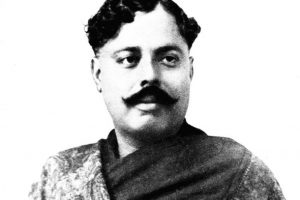
He is very well-known. He was Girija babu’s student. He followed the method generally used to teach young girls – short pieces like bandish and m?lkosh, beh?g, bhupali – he taught us these. He made us write pre-composed taan and bist?r. I don’t think there was a tabla. He kept the beat himself with his hand. Then I used to leave again, but the lesson remained with me. That’s how I learn to sing. My mother really wanted me to learn kirtan. She used to sing kirtan herself. The famous Ratneshwar Mukherjee taught me many kirtans. I trained with him for about three months. He taught me many difficult songs. But one day Jamini babu told my mother that if I learn two kinds of singing, it might harm my voice. The throw of the voice for kirtan was different from the kind of throw required for singing kheyal. He said that he felt that she should choose any one for me. Anyway, I left after that, and didn’t continue learning kirtan. Whenever I did learn after that, I learnt either kheyal or thumri. Then there was no scope to learn in America. But all the students used to put up performances – we sang bhajan and Rabindra Sangeet. If there was some occasion…
I: There were no opportunities of singing classical songs in America?
P: I knew how to sing thumri. Jamini babu had taught me that. So if someone requested me to sing thumri at some programme, I could do that. I didn’t sing kheyals very often. I mostly sang bhajans. Many of the students who came to America knew how to sing, they would teach us. One such person, who was well-known, was Bhupen Hazarika. He used to teach us, and we sang as a chorus. Then, I think it was in 1957 that my father left the United Nations and took up a job in the Planning Commission in Delhi. Jawaharlal Nehru had called him. So my father said to me, “You don’t have to stay here. You come with me.” I was studying in a college there; I used to receive a scholarship. But my father said, “A lot of people study. Don’t tell me all this. You will learn how to sing.” I was very surprised. I couldn’t understand why my father was insisting that I learn classical music at that age. My father always wanted me to learn how to sing. Even when I was a child in Baroda, that environment of music and songs was there. I heard a lot of great songs. And I used to sing. That is, I used to sing spontaneously, not because I was learning how to sing. I think that is why my father thought that I should learn it properly.
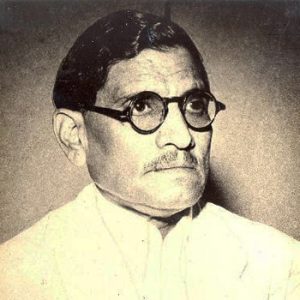
Then my father requested Ustad Vilayet Hussain Khan Saheb to teach me. He didn’t readily agree because he didn’t teach such novices. His disciples were famous! Sumati Mutatkar! Gajanand Ram Joshi! Ram Marathe! These were his assistants. Anyway, he heard me and said, “Okay, may be you will be able to learn.” He started from scratch. He always told me that the harder you work, the more you will develop. I couldn’t understand all that then. I hadn’t experienced the depth of classical music then. But this was something he always used to say, “The harder you work, the better you become. Your music will progress. He used to say that when they used to practice when they were young, often they fell asleep. Then either his father or mother would come and pour cold water on them. Then they’d wake up and start again. But he used to say to me, “I am not asking you to do that. You practice for half ‘n’ hour, that’ll do.” I was so embarrassed to hear this that I began to do my riyaaz more seriously. I was trained under him for two years. From someone who knew nothing, I realized at the end of the two years that he had taught me a lot. But I cannot explain what the technique of teaching was. He was very hard working. Who was I? I used to think of myself as…
I: You had the potential, that is why…
P: Maybe he thought that someday I’d be able to sing well. He used to work so hard that I used to feel embarrassed. Anyway, after two years, I moved to Kolkata. That was when I got married. After I got married, I used to live in Kolkata.

Ustad Ata Hussain Khan was the maternal cousin of Vilayet Hussain Khan. He was a great ustad as well. He lived in the Mahishadal palace. I came to him and he agreed to teach me. They were wonderful human beings. But they were also very reserved. So, very often, I used to feel scared to communicate with them. When he started to train me, he first heard what I had learn previously. He didn’t make any comments. He listened silently. After that, on the first day of training, he made me hear deshi tori. I hadn’t heard this name before and didn’t have any ideas of it. I didn’t know about the song at all. Anyway he sang the song. And he said, “You try and follow me while I sing. Sing along with me.” I did as much as I could. Then he sang the taan. He was a master of the taan. He performed a tin chakkar taan and said to me, “Now you try it.” I said, “Khan Sahib, how will I do it? I can’t understand a thing. I can’t understand the movement of the notes.” He said to me, “You don’t have to understand all that. You only have to keep your ears perked. You have to try and imitate me. You don’t need to know the sargam. Try only to copy it.” I was groping in the darkness. It was such a complicated taan! My voice wasn’t that bad. But it was a very complicated taan and a very complicated raag. I failed the first time. I failed the second time as well. At this point I was praying to the heavens to help me! If I failed again, I would feel extremely embarrassed! After the fifth attempt he said in Hindi, “Now, you’ve managed to do something. Now it’s okay.” He was testing how much I could produce through only hearing an unfamiliar tune. In later training, I saw that this practice helped me a lot. They never made us write sargams. And we didn’t have tape recorders back then. There was no support. You’ll hear it, produce it, and remember it. No looking at a copy. That develops a kind of power. That helped a lot. Even now, even if I haven’t sung a song for a long time, I see that I can sing it. This is because of my gurus. They made me sing the same song so many times. I used to think, I have sung well so why is he making me sing it so many times, why do I have to repeat it? But my guru said, “If you keep repeating the song every day, the song will be embedded within you in such a way that you will never forget it.” The contribution of the teacher is massive. If he didn’t introduce me to this, how would I have known? So my training progressed. Sharafat Khan sahib was the nephew of Ata Hussain Khan sahib and the son-in-law of Vilayet Hussain Khan. So he was a part of the family. All of them, and Yunus Khan sahib as well, used to really help all the new students. This helped them to sing better. Or maybe they’d make them understand some other point. Sharafat Khan used to come to Kolkata regularly. He used to attend the music conferences. He came with Khan sahib and taught me. Maybe it would be just one very complicated taan. I used to think, how can I sing this? I’ve never heard such a taan before. There was one taan which was a mix of three or four taans. I remember one such taan in gara kanada, which he showed me, and he left. He said, “When I return after three months, I want to hear this.” At first I was very confused. But then I began to try. Actually, I had internalised the material. Sort of like a computer. So when I tried again, it didn’t work straightaway, but after a few days I realized that I was able to sing it. Maybe it wasn’t that good, but it was alright. So I found a way. Once you find such a path, you can develop your own taan. Their method of teaching was such that I could pick up a completely unfamiliar song in a couple of days without even realizing how I did it. Such was the quality of their training.
I: The taan that you were talking about did they perform complex taans for simple raags?
P: Yes, yes. They did simple ones and complex ones as well. Yes, of course.
I: Even in Vilayet Khan’s music, there are several uses of the complex taan.
P: Yes. They performed complex taans for all kinds of raagas, but they kept the simple taans as well. It is not like they left out the simple ones altogether. Of course, there would be some raagas without any simple taan. In such cases, only the complex ones would be used. So this is how my training progressed. In 1980…
I: How long did this continue from 1957?
P: Till 1980. I got married in 1958. After I moved to Kolkata, there was a break in my training. I hadn’t found Khan sahib at that time. Then I started again in ’60-61. Then he fell ill, had a heart attack, and went home. There were several gaps in the training. Then between 1950 and 1960 my son was born. The family life was also important. So there was a gap again. But I sang on and off. That is how it was

Then in 1970, Ata Hussain Khan sahib returned. His health had improved. He was there from 1970 to 1980. He went home for a couple of months every year. And Sharafat Khan sahib used to visit very frequently as well during this time. And Yunus Khan sahib used to visit as well. I have been helped by them. I have heard them sing. I have also heard Latafat Khan sahib. Khadim Hussain Khan had visited us a few times. They all had different styles of singing, as it should be with creative artists. But basically, the gharana was the same. Hearing it helped us a lot. In 1980, Khan sahib passed away. In ’85, Sharafat Khan sahib passed away. He didn’t teach me for two years, but he was there through the rest of the training process. I didn’t train any more after that. But Yunus Khan sahib used to visit, and he always encouraged me to sing bandishes composed by him. He used to say, “Sing them and make them popular, you go abroad to perform.” He had composed many raagas. Of these, there was one called sujaani malhar. It was like sur malahar. He named it sujaani after Sujaan Khan Haji was the proponent of the gharana. He was a contemporary of Tansen and was a part of Akbar’s court. He was also called Deepak Jyot because he sang the Deepak raaga so beautifully. His is the first name we encounter in the Nauharbani gharana. There were others before him, certainly, but his name has survived, probably because he was a part of the court of Akbar. Yunus Khan taught me sujaani malhar and said, “Sing it a lot and make it very popular!” I did sing it. I sang it for the radio, and in programmes of the Agra gharana where I have been invited to speak. That is one satisfaction I have – that even though he isn’t here, I have sung his song. The gurus have taught me how to sing. But that’s not the end of it. Maybe he has taught me a song, but I am having problems in singing it. Then I have to develop it myself in my heart. They showed me the way – the path on which I could develop these songs for myself. And one day I’d realize that the song was ready. I would never sing a song unless I knew that it was absolutely ready and that I was completely prepared.
I: What is the difference between the sur malhar and the sujaani malhar? In what aspects do they vary?
P: I cannot explain it in words. One has to hear it to understand the variations.
Translated by: Sarbajaya Bhattacharya
Picture Courtesy: Google
http://www.itcsra.org/TributeMaestro.aspx?Tributeid=28
http://www.kolkataonwheels.com/a-touch-of-royalty/
http://www.itcsra.org/TributeMaestro.aspx?Tributeid=25
Edited & Designed: Ms. Rajeswary Ganguly Banerjee
Data processed at SAP-DRS Lab, Department of Instrumental Music, Rabindra Bharati University.

